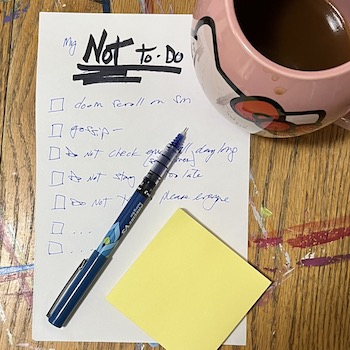Benefits of a ‘Not To-Do’ list

In our fast-paced, goal-oriented society, to-do lists are a common tool for staying organized and productive. They help us prioritize tasks, set goals, and ensure we don't forget important responsibilities. But have you ever considered the power of a "Not To-Do" list? While to-do lists help us focus on what needs to be accomplished, a "Not To-Do" list can provide a different kind of mental clarity and mental health benefits.
Some of the benefits include:
- Reduces Overwhelm - One of the most significant mental health benefits of a "Not To-Do" list is its ability to reduce overwhelm. Modern life bombards us with endless tasks, commitments, and distractions. This constant influx of information can make it challenging to stay focused and can lead to feelings of anxiety and stress. By identifying and listing things you should not be doing, you can lighten your mental load and create a sense of control over your responsibilities.
- Encourages Mindfulness - Creating a "Not To-Do" list forces you to be mindful of your habits and behaviors. Often, we engage in activities or behaviors that are counterproductive or detrimental to our mental health without even realizing it. Writing down these negative patterns can make you more aware of them, helping you make conscious choices to avoid them in the future.
- Sets Boundaries - Boundaries are essential for maintaining healthy relationships and preserving your mental well-being. A "Not To-Do" list can serve as a tool for establishing and maintaining these boundaries. By identifying tasks or commitments that drain your energy or make you unhappy, you can set limits on what you're willing to tolerate, fostering healthier relationships and reducing stress.
- Prioritizes Self-Care - Taking care of your mental health is crucial, but it's often neglected in the hustle and bustle of daily life. A "Not To-Do" list can include items that prioritize self-care. Whether it's saying no to additional work when you're already stretched thin or avoiding excessive screen time, these entries remind you to put your well-being first.
In a world that often prioritizes busyness and productivity, taking a step back to create a "Not To-Do" list can be a valuable tool for improving your mental health. This simple practice can lead to a happier and healthier you.
Try This
To create your Not To-Do list you can start by reviewing your past calendar and lists. Look for areas that may take more time than necessary and determine if there is a better way to do them. Are there items on your list that you can delegate?
Look for things throughout your day that take a lot of time or cause anxiety that you might not have ever noticed. For example, do you tend to scroll social media randomly during the day? This activity can take a lot of time since we usually don’t pay attention to how long we’re scrolling or how many little videos we’ve watched. Too much screen time can cause anxiety and sleep issues as well.
Once you have determined a few things that you can put on your Not To-Do list, review again at the end of the week to see how it has helped.
Connect with us:
The C.A.R.E. Program team would love to connect with you!
- Register for one of our Caregivers classes
- Join the conversation in our Facebook group
References:
.svg?iar=0&hash=F6049510E33E4E6D8196C26CCC0A64A4)

/hfh-logo-main--white.svg?iar=0&hash=ED491CBFADFB7670FAE94559C98D7798)